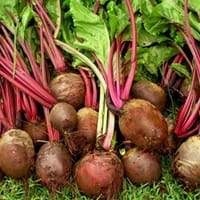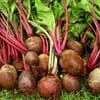Life Span
Biennial
Biennial and Perennial
Origin
Europe
Europe, Western Asia
Types
Detroit Dark Red Beet, Early Wonder Tall Beet
Not Available
Number of Varieties
Not Available
Habitat
Not Available, Unknown
waste ground, wastelands
USDA Hardiness Zone
6-10
4-9
Sunset Zone
A1, A2, A3, H1, H2, 1a, 1b, 2a, 2b, 3a, 3b, 4, 5, 6, 7, 8, 9, 10, 11, 12, 13, 14, 15, 16, 17, 18, 19, 20, 21, 22, 23, 24
A1, A2, A3, H1, H2, 1a, 1b, 2a, 2b, 3a, 3b, 4, 5, 6, 7, 8, 9, 10, 11, 12, 13, 14, 15, 16, 17, 18, 19, 20, 21, 22, 23, 24
Habit
Clump-Forming
Rosette/Stemless
Flower Color
Red, Green
Yellow
Flower Color Modifier
Not Available
Bicolor
Fruit Color
Not Available, Tan
Brown, Black
Leaf Color in Spring
White, Yellow, Red, Green, Orange, Dark Green
Green
Leaf Color in Summer
White, Yellow, Red, Green, Orange, Dark Green
Green
Leaf Color in Fall
White, Yellow, Red, Green, Orange, Dark Green
Green
Leaf Color in Winter
Not Available
Not Available
Leaf Shape
Spinach Type
Pinnate
Plant Season
Spring, Summer, Fall
Summer
Sunlight
Full Sun
Full Sun
Growth Rate
Very Fast
Medium
Type of Soil
Loam, Sand
Loam
The pH of Soil
Neutral
Neutral
Soil Drainage
Well drained
Well drained
Bloom Time
Late Spring, Early Summer, Summer
Summer
Tolerances
Not Available
Drought
Where to Plant?
Ground
Ground, Pot
How to Plant?
From bulbs, Seedlings
Seedlings
Plant Maintenance
Medium
Medium
Watering Requirements
Needs watering once a week, Over-watering can cause leaf problems or root diseases, Water Deeply
Average Water Needs, Do Not over Water, Keep the ground moist but not water-logged
In Summer
Lots of watering
Lots of watering
In Spring
Moderate
Moderate
In Winter
Average Water
Average Water
Soil Type
Loam, Sand
Loam
Soil Drainage Capacity
Well drained
Well drained
Sun Exposure
Full Sun
Full Sun
Pruning
Cut or pinch the stems, Prune to stimulate growth, Remove damaged leaves, Remove deadheads
Remove damaged leaves, Remove dead branches, Remove dead leaves
Fertilizers
All-Purpose Liquid Fertilizer
All-Purpose Liquid Fertilizer
Pests and Diseases
Flea Beetles, Leaf Hoppers, Mexican Bean Beetles
Aphids, Armyworm, Cutworms, Downy mildew, Pitch canker, Red blotch
Plant Tolerance
Drought
Drought
Flowers
Insignificant
Showy
Flower Petal Number
Not Available
Not Available
Fragrant Bark/Stem
No
Yes
Foliage Texture
Coarse
Fine
Foliage Sheen
Matte
Matte
Attracts
Not Available
Butterflies
Allergy
breathing problems, dark circles, hairloss, Runny nose, Sore Throat, wheezing
Stomach burn
Aesthetic Uses
Not Available
Not Available
Beauty Benefits
Not Available
Blood purifying, Good for skin
Environmental Uses
Air purification
Air purification
Medicinal Uses
Diabetes, Digestive disorders, Heart problems, High blood pressure, Inflammation, Unknown
Aphrodisiac
Part of Plant Used
Fruits
Root
Other Uses
Used As Food
Food for animals, Used as a nutritious food item
Used As Indoor Plant
No
Yes
Used As Outdoor Plant
Yes
Yes
Garden Design
Bedding Plant, Edible, Herb / Vegetable
Edible, Herb, Vegetable
Botanical Name
BETA vulgaris 'Early Wonder Tall'
PASTINACA sativa
Common Name
Beet, Early Wonder Tall Beet
Parsnip
In French
betterave
Panais
In Spanish
remolacha
Chirivía
In Greek
παντζάρι
Είδος δαυκίου
In Portuguese
beterraba
cherivia
In Polish
buraczany
Pasternak
In Latin
cui pendens sicula beta
parsnip
Phylum
Streptophyta
Magnoliophyta
Class
Caryophyllidae
Magnoliopsida
Order
Not Available
Apiales
Family
Chenopodiaceae
Apiaceae
Clade
Not Available
Angiosperms, Asterids, Eudicots
Tribe
Not Available
Not Available
Subfamily
Not Available
Not Available
Number of Species
Not Available
Properties of Beet and Parsnip
Wondering what are the properties of Beet and Parsnip? We provide you with everything About Beet and Parsnip. Beet doesn't have thorns and Parsnip doesn't have thorns. Also Beet does not have fragrant flowers. Beet has allergic reactions like breathing problems, dark circles, hairloss, Runny nose, Sore Throat and wheezing and Parsnip has allergic reactions like breathing problems, dark circles, hairloss, Runny nose, Sore Throat and wheezing. Compare all the properties and characteristics of these two plants. Find out which of these plant can be used as indoor plant. If you are interested to decorate your house and garden, find out aesthetic uses, compare them and select the plant which will beautify your surrounding. Along with beautification, try comparing medicinal and edible uses of Beet and Parsnip and you can choose the plant having best and most benefits.
Season and Care of Beet and Parsnip
Season and care of Beet and Parsnip is important to know. While considering everything about Beet and Parsnip Care, growing season is an essential factor. Beet season is Spring, Summer and Fall and Parsnip season is Spring, Summer and Fall. The type of soil for Beet is Loam, Sand and for Parsnip is Loam while the PH of soil for Beet is Neutral and for Parsnip is Neutral.
Beet and Parsnip Physical Information
Beet and Parsnip physical information is very important for comparison. Beet height is 30.00 cm and width 15.20 cm whereas Parsnip height is 15.20 cm and width 7.60 cm. The color specification of Beet and Parsnip are as follows:
Beet flower color: Red and Green
Beet leaf color: White, Yellow, Red, Green, Orange and Dark Green
Parsnip flower color: Yellow
- Parsnip leaf color: Green
Care of Beet and Parsnip
Care of Beet and Parsnip include pruning, fertilizers, watering etc. Beet pruning is done Cut or pinch the stems, Prune to stimulate growth, Remove damaged leaves and Remove deadheads and Parsnip pruning is done Remove damaged leaves, Remove dead branches and Remove dead leaves. In summer Beet needs Lots of watering and in winter, it needs Average Water. Whereas, in summer Parsnip needs Lots of watering and in winter, it needs Average Water.





